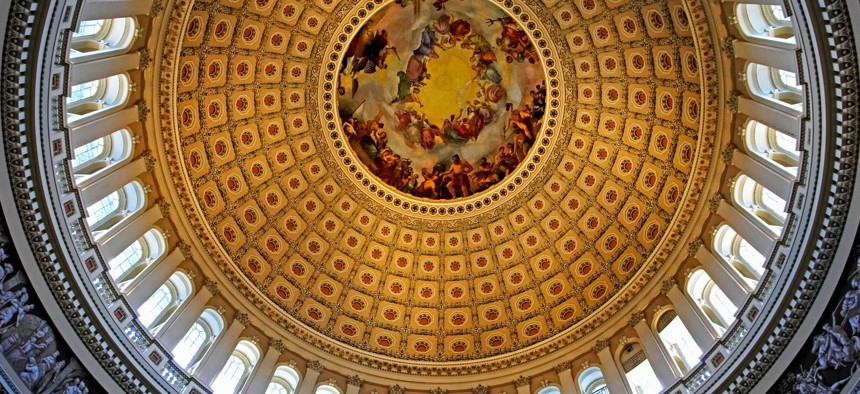States and Localities See Big Infusion of Cash From Earmarks

The interior of the U.S. Capitol dome. Allan Baxter/Getty Images
The once-tainted, but now revived process to fund congressional lawmakers’ favored projects is sending hundreds of millions of dollars to state, local and tribal governments.
The return of congressional earmarks this year has been a boon for states and localities, particularly in getting transportation funding, according to new reports from the Government Accountability Office.
As intended by Democratic lawmakers who restored the process, much of the money set aside for members of Congress to send home for projects they favor has gone to state, local and tribal governments under the fiscal 2022 budget.
For example, 475 of the 478 projects funded with the $1.5 billion in grants being administered by the Transportation Department will go to those levels of government, according to one of five GAO reports released Monday examining how federal agencies are planning to administer the funds and monitor whether they are spent properly.
Similarly, 43 of the 65 Energy Department projects funded with $103.1 million in earmarks will be going to state, local and tribal governments, according to another one of the reports. The rest of that funding, which will help pay for projects related to addressing climate change and improving the electrical grid, will flow to higher education institutions and nonprofits.
Funding for 22 of the 75 projects being funded with the $117.2 million in earmarks that will be administered by the Interior Department is headed to states, localities and tribes, largely for water resources projects in the West, GAO also reported.
But much of the Interior money will go to federal agencies, including to the Bureau of Reclamation, to acquire land, and to the National Park Service, which will send funds to nonprofit groups around the country for historic preservation, including the National Underground Railroad Freedom Center in Cincinnati, Ohio.
The earmark process was banned in 2011, with critics deriding it as an example of Washington’s “swamp,” political culture. Often cited is a $223 million earmark Alaska’s congressional delegation secured to build a massive bridge for a city so small that the project was derided as the “Bridge to Nowhere.”
In resurrecting earmarks, the House Appropriations Committee’s Democratic chairwoman, Rosa DeLauro of Connecticut, enacted a number of reforms, including barring members of Congress from asking for money for for-profit entities.
Under the new rules, the so-called Community Project Funding can only go to states, localities and nonprofit groups.
According to congressional data, lawmakers sent local governments $2.7 billion for 1,874 projects. And that’s on top of billions that states and localities are getting from the Biden administration’s American Rescue Plan Act and the Infrastructure Investment and Jobs Act.
Transportation projects funded at the request of lawmakers using earmarks “range from small projects, such as upgrading sidewalks, to larger projects, including concourse renovations for airports,” according to the GAO.
Funding for transportation projects was as little as $30,000 and as much as $100 million, with more than 80% of the projects receiving less than $5 million per project, the GAO also found.
The big winners for transportation dollars, it said, were Alabama and California, which received a combined $313 million in—what some refer to derisively as—“pork” spending. Alabama saw the largest funding for an individual project: $100 million to construct a new international terminal at the Mobile Downtown Airport.
Entities in California received 68 grants, the most of any state. Combined the grants totaled $144 million, according to the report.
While a win for states, localities and tribes, officials in the Energy and Interior departments said they were concerned administering the money will increase the workload for their staff. Transportation officials, however, said their staff could handle overseeing the money.
Earmarks’ controversial past apparently will not bring about heightened scrutiny by agencies compared to other federal spending—at least not in the near term. The departments GAO examined—including the General Services Administration and the National Archives and Records Administration—said they plan to use the same processes to ensure the funds are not wasted or lost to fraud as with other federal grants.
Kery Murakami is a senior reporter for Route Fifty.
NEXT STORY: New Analysis Looks at Where People Pay the Most in Property Taxes






